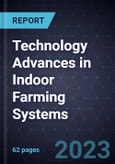The world is experiencing unrelenting trends in population growth, decreasing water supply, urbanization, and climate change, all of which contribute to dwindling arable land stock. The United Nations (UN) Food and Agriculture Organization (FAO) estimates that the global population will reach 9.7 billion by 2050 and exceed 11 billion by 2100. To achieve food security, global food production will need to increase by up to 70% in the next 30 years. Today, unprecedented circumstances such as geopolitical tensions and pandemics are causing supply chain disruptions, limiting people's access to food in certain areas, particularly in countries that are already suffering from high levels of food insecurity.Integrating Advanced Farming Techniques with Controlled Environment Agriculture to Significantly Improve Yield while Enabling Resource Efficiency and Food Security
Globally, the consensus is that agriculture must adopt more effective resource utilization methods, those that require less water and chemicals to produce crops with high yields. New farming technologies, such as indoor farming, provide an excellent way to meet these challenges. Indoor farming could increase crop (including fish) production substantially while decreasing the size of agriculture’s environmental footprint. The shift to indoor farming would create access to a clean and green source of food, improve the nutritive value of food, lower transportation costs, and ameliorate food shelf-life as well as pests, droughts, and bio-security issues. Indoor farming incorporates advanced farming techniques classified as controlled environment agriculture (CEA) that comprises technologies to optimize growing conditions for plants. CEA regulates variables such as temperature, lighting, and humidity, allowing farmers to grow plants that would otherwise be impossible in certain climatic and weather conditions. These advanced farming techniques have the potential to significantly increase crop yield while optimizing resource utilization.
This study on the technological advances in indoor farming systems covers the following research and analysis areas:
- Overview of indoor farming technologies, trends, and factors driving the development and adoption of various farming systems
- Patent landscape and growth opportunities enabling the development and adoption of indoor farming
- Major stakeholders active in the indoor farming landscape








